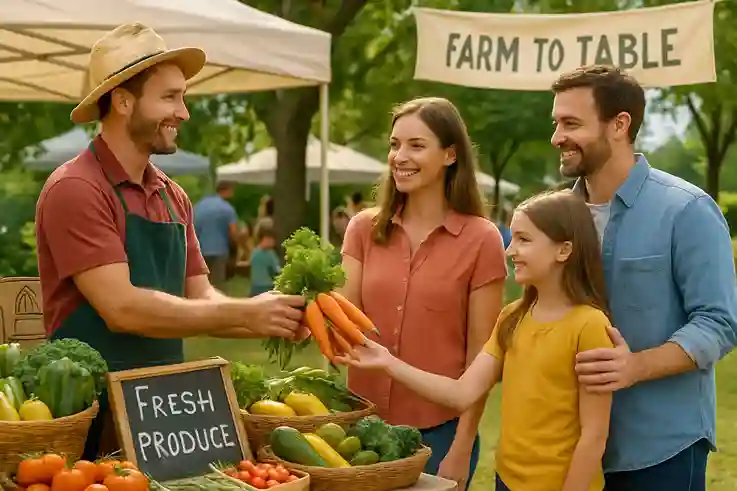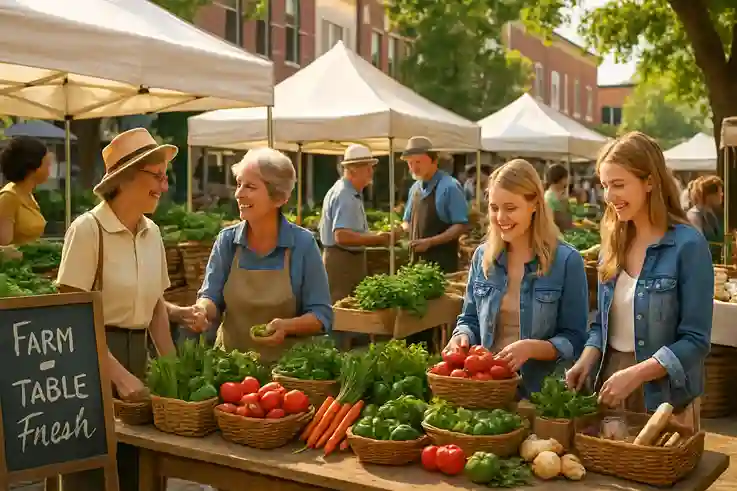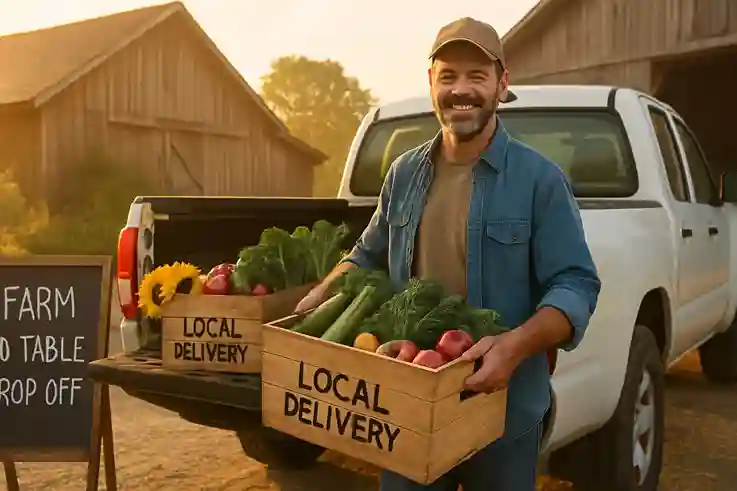Farm-to-Table: How to Market Your Harvest Locally
Farm to Table isn’t just a trend — it’s a growing movement across the U.S. that connects local growers with community buyers. If you’ve been growing fresh produce, raising livestock, or crafting homemade farm goods, you’re already part of something valuable. But selling locally takes more than quality products. It requires a deep understanding of your local market, what your customers care about, and how to reach them.
More Americans now want to know where their food comes from — and they prefer it fresh, ethical, and grown nearby. Whether you’re a small farmer, homesteader, or backyard grower, this shift is your opportunity. You can build a trusted local brand and create lasting customer relationships.
This guide shows you how to market your harvest effectively in your own community — from farmers markets and CSA boxes to selling in neighborhood stores.
Why Sell Locally?

Selling your harvest close to home offers real, lasting advantages. It’s not just about moving products faster — it’s about building something meaningful. When you sell locally, you strengthen your income, reinforce your values, and deepen your ties to the place you live.
Local selling puts you in direct contact with your customers. You get immediate feedback, develop trust, and create relationships that last beyond a single transaction. You’re not just another seller — you become part of your community’s food story.
Keep More of Your Profits
Selling directly to your community allows you to keep a larger share of each sale. Without middlemen, you’re not splitting profits with wholesalers, distributors, or large retailers. That means more of the money goes straight into your hands — not someone else’s pocket. For small farmers or homesteaders, this can be the difference between barely breaking even and growing a reliable income stream. It also gives you full control over how your products are priced and packaged, letting you set fair rates that reflect your time, labor, and quality.
Direct sales also streamline how and when you get paid. Whether you’re at a weekend market or running a CSA, you know when money is coming in. No long waits for invoices, no unpredictable payments. You can reinvest faster — in seeds, equipment, or expansion — without relying on loans or seasonal credit. The Farm to Table approach isn’t just about food transparency for the customer; it’s about economic independence for the farmer. With fewer outside demands and direct customer relationships, your business becomes more sustainable — and more rewarding — on your own terms.
Attract Loyal, Local Buyers
Today’s shoppers care more than ever about where their food comes from. They want to know who grew it, how it was raised, and what went into producing it. This desire for transparency has fueled the rise of the Farm to Table movement — a shift that favors local growers over anonymous supply chains. When you sell locally, you’re not just offering a product — you’re offering trust. Customers can ask questions, hear your story, and feel confident about what they’re feeding their families.
That trust builds loyalty. Once someone discovers the flavor, quality, and freshness of local food, they often come back week after week. They’ll remember the tomatoes you brought in July or the fresh eggs they bought last Saturday. Over time, these repeat customers become your biggest supporters. They’ll share your farm with friends, follow your updates, and even adjust their weekly shopping habits around your availability. This kind of relationship isn’t possible with distant or online sales. It’s built through consistency, conversation, and shared values — the foundation of a thriving local customer base.
Build a Strong Reputation
One of the biggest advantages of selling locally is the ability to connect directly with your customers. The Farm to Table experience is about more than just fresh food — it’s about relationships. When people can talk to the person who grew their vegetables or raised their meat, they feel a stronger sense of connection. That trust is hard to earn through grocery store shelves or digital checkouts. It’s something built slowly through conversation, transparency, and consistency.
Personal interactions matter. Happy customers share their experience, helping your farm grow through word-of-mouth. A kind gesture at your market stall or a quick chat about growing methods can stick with someone long after they leave. Over time, your customers become more than one-time buyers — they become advocates for your farm. They’ll bring friends, recommend you online, and support you through slow seasons. These connections are powerful marketing tools, and they’re built into the heart of every Farm to Table exchange.
Cut Costs on Transport and Packaging
Selling close to home reduces more than just distance — it simplifies your entire operation. When you market within your community, you don’t need complex logistics, bulk shipping arrangements, or third-party carriers. Your delivery routes are shorter, and your packaging can be minimal. That means fewer supplies, lower fuel use, and less time spent coordinating orders. Every mile you don’t drive adds back time and savings to your day.
These small efficiencies add up. Local selling helps reduce wear and tear on your vehicles, cuts down on refrigeration needs, and limits packaging waste. You also avoid the hidden costs of long-haul distribution — such as storage fees, cold-chain requirements, or product damage in transit. The Farm to Table model works in your favor here. By focusing on a smaller, nearby customer base, you can streamline your workflow and operate with more flexibility. Less stress. More control.
Reduce Your Environmental Impact
The environmental impact of local food is hard to ignore. Farm to Table practices are built on short supply chains, minimal transport, and low packaging waste. That translates to fewer carbon emissions, less fuel consumption, and a smaller ecological footprint. Every time you sell nearby, you’re reducing the environmental cost of getting food from field to plate.
Local food systems also waste less. Smaller harvests are easier to manage, and direct sales mean fewer products go unsold or spoiled. There’s no need for excessive plastic wrap, foam coolers, or long-term storage solutions. By keeping your distribution tight and focused, you help create a food economy that values efficiency, freshness, and long-term sustainability. Farm to Table isn’t just good for business — it’s better for the planet.
Stay Visible in Your Community
Being present in your local area does more than move products — it builds trust. When you show up at farmers markets, community events, or local shops, people get to know you. They recognize your face, ask about your produce, and look forward to your next visit. Over time, you become part of the local rhythm — not just a business, but a familiar presence. You’re not just a grower — you’re a neighbor.
This visibility helps your farm stand out in ways that ads and social media can’t. People remember who they met, not just what they bought. The Farm to Table experience becomes more personal, more connected, and more valued. Your story, your growing methods, and your passion all become part of the product. That connection keeps customers loyal — and makes your work feel more meaningful. In a world full of mass production, showing up locally is your strongest brand.
1. Farmers Markets: Your Local Launchpad

Why It Works:
Built-In Foot Traffic
Selling at farmers markets gives you instant access to customers already looking for what you offer. These markets draw steady crowds of people who value freshness, seasonality, and local sourcing — all core to the Farm to Table approach. You don’t need a storefront or a big advertising budget. Just showing up puts your products in front of the right audience, week after week. It’s one of the most effective ways to gain exposure, build a following, and connect with shoppers who are ready to buy.
Instant Feedback from Customers
One of the biggest advantages of local selling is the ability to talk directly with the people buying your food. At markets or local events, you can ask questions, hear opinions, and watch reactions in real time. This instant feedback helps you understand what your customers love, what they’re asking for, and what could be improved. It’s a powerful tool for growth that’s built into the Farm to Table model. You don’t need surveys or sales reports — just honest conversations that help you shape your offerings to match real demand.
Great for Building Your Brand and Trust
Face-to-face interaction is one of the most powerful ways to build credibility. When shoppers meet the person behind the produce, eggs, or homemade goods, it creates a lasting impression. You’re not just a name on a label — you’re a real, trusted part of their food source. That kind of transparency is rare in today’s food system, which is why it’s central to the Farm to Table experience. Over time, these personal connections strengthen your brand and encourage long-term customer support rooted in trust.
2. Start a CSA (Community Supported Agriculture)
What Is a CSA?
A CSA, or Community Supported Agriculture program, allows customers to buy a portion of your harvest in advance. They pay upfront for a weekly or bi-weekly box filled with seasonal produce, herbs, eggs, or other farm goods. This model gives you early-season income and a stable customer base, while buyers enjoy fresh, local food straight from the source. It’s a core part of the Farm to Table system — one that builds commitment, reduces waste, and deepens the connection between grower and eater.
Benefits of a CSA
A CSA isn’t just good for customers — it offers real, lasting advantages for small farms. Here’s how it helps your operation thrive:
Predictable Income
One of the biggest challenges for small growers is uncertain cash flow. With a CSA, you receive payments upfront — often at the beginning of the season. This gives you working capital when you need it most. You can invest in seeds, equipment, and labor before your harvest begins. Instead of relying on weekly sales, you start the season with income in hand. That financial stability helps reduce stress and supports smarter planning for the months ahead.
Builds Long-Term Customer Relationships
CSA members aren’t just one-time buyers — they become part of your farm’s journey. As they pick up their weekly or bi-weekly boxes, they get to know your growing practices and appreciate the effort behind each harvest. That connection often leads to loyalty, referrals, and ongoing support. Many CSA customers return season after season. This long-term relationship turns your farm into more than a food source — it becomes part of their lifestyle. The Farm to Table model thrives on trust, and a CSA helps build it.
Allows for Better Planning
Knowing how many customers you’re feeding — and what they expect — allows you to plan with confidence. With a CSA, you can map out your planting schedule based on committed demand. This reduces waste, improves crop rotation, and helps you time your harvests more efficiently. You grow with purpose, not guesswork. Whether you’re including leafy greens, root vegetables, or fresh herbs, you can tailor each box to match the season and customer preferences. It’s a smarter, more strategic way to manage your farm.
3. Sell to Local Stores & Cafes

Who Buys Local Produce
Independent Grocery Stores
Local grocery stores — especially independently owned ones — are always looking for ways to stand out from larger chains. They often seek fresh, seasonal, or hard-to-find items that appeal to health-conscious and community-focused shoppers. This is where your farm can shine. By offering high-quality, local produce, you give them a reason to support regional sourcing. Approach store owners or managers directly. Bring samples, explain your growing methods, and highlight what makes your harvest unique. The Farm to Table trend is strong, and grocers know customers trust food that’s grown nearby. A strong relationship can lead to regular orders, in-store promotions, and long-term visibility for your farm.
Farm-to-Table Restaurants
Small restaurants that focus on seasonal, locally sourced food are ideal partners for your farm. Many chefs prefer working directly with growers so they can build rotating menus around what’s fresh and available. These relationships allow you to sell premium-quality produce, herbs, eggs, or specialty items at a fair price. Start by identifying independent or Farm to Table restaurants in your area. Visit during off-peak hours, introduce yourself, and bring samples if possible. Be clear about your growing practices, seasonal availability, and delivery options. Chefs value reliability, transparency, and uniqueness — and if your harvest meets their needs, they’re likely to become regular buyers who proudly promote your farm on their menu.
Juice Bars and Cafés
Juice bars and cafés are always looking for ultra-fresh ingredients. Herbs, leafy greens, fruits, and edible flowers are in constant demand for smoothies, wellness shots, and seasonal dishes. Even if your supply is small, consistent weekly deliveries can turn into a steady income stream. These businesses often prefer working with local farms to ensure freshness and flavor. They also love sharing the source of their ingredients with customers. Position your farm as a reliable, high-quality local supplier. The Farm to Table appeal adds value to their brand — and keeps your products moving off the shelf.
Health Food Co-ops
Health food co-ops are built around community and sustainability. They often prioritize local growers over national brands, especially when you use organic or regenerative practices. These co-ops value transparency and personal relationships. They may also promote local partners through in-store signage, newsletters, or events. Approach them with a clear list of what you grow, how it’s produced, and when it’s available. If your values align with theirs, you’ll likely find a long-term market for your goods. The Farm to Table movement fits perfectly within the co-op model — where ethics, quality, and community all matter.
Tips for Approaching Local Buyers
Reaching out to restaurants, shops, or co-ops requires more than just good produce. How you present yourself matters just as much as what you grow.
Bring a Sample Basket and Price List
Your first impression sets the tone. Show up with a clean, well-organized basket that highlights your best seasonal produce. Use attractive packaging and clear labeling. Include a printed price list that’s easy to understand and professionally formatted. This shows you treat your farm like a real business — and that you’re ready to partner seriously with local buyers. It also gives them something tangible to review after your visit.
Explain Your Growing Practices
Be prepared to talk about how you grow your food. Whether you’re using organic methods, regenerative practices, or pesticide-free systems, transparency builds trust. Local buyers want to know what makes your farm different from commercial operations. This is especially important in the Farm to Table space, where growing methods matter just as much as flavor. Don’t assume they already know — take the time to explain it clearly.
Be Professional and Reliable
Even small buyers need consistency. If you commit to delivering greens every Tuesday, make sure you follow through. Local businesses depend on reliable suppliers to keep their own operations running smoothly. Clear communication, accurate timing, and follow-through will help you build long-term, profitable relationships. Being part of the Farm to Table network means showing that you’re not just passionate — you’re dependable.
Offer Unique, Seasonal Items
What sets you apart from big distributors? Specialty crops like heirloom tomatoes, baby greens, edible flowers, or fresh herbs can grab attention. These unique items help restaurants, cafés, and shops stand out — and they’ll come back to you for more. Local buyers love ingredients they can’t find anywhere else. The more diverse and seasonal your offerings, the more value you bring to the Farm to Table movement.
Build a Local Brand
Creating a strong identity for your farm helps you stand out in a growing local market. Start with a name that reflects your mission, location, or personality — something easy to remember and meaningful to your customers. A clean, simple logo can go a long way. Use it on signs, labels, packaging, and social media to give your products a consistent, professional look. Recyclable packaging with your branding not only supports sustainability but also makes your goods look polished and reliable. These small touches help customers recognize and trust your farm at a glance.
Don’t forget to tell your story. People connect with real growers — not just products. Whether you share your background online, include a personal note in CSA boxes, or talk to customers at the market, your story matters. Let them know why you farm, what you value, and how your growing practices reflect those beliefs. This personal touch is at the heart of the Farm to Table movement. It builds loyalty, deepens customer relationships, and reminds people that their food comes from someone they know and trust.
Where to Market Your Local Harvest
Marketing your harvest locally starts with meeting people where they already are. Platforms like Facebook Marketplace let you list fresh produce, eggs, or homemade goods for nearby buyers—quickly and for free. Instagram is perfect for sharing photos of your harvest, garden updates, and daily life on the farm, building a personal connection with followers who value transparency and freshness.
Posting in local Facebook groups, parenting communities, and neighborhood forums can attract loyal, repeat customers who care about supporting local food systems. To reach beyond your immediate area, join trusted farm directories like LocalHarvest.org or EatWild.com. These platforms connect you with shoppers who actively seek Farm to Table options and are eager to support growers just like you.
Launch a Simple Website or Email List
You don’t need a fancy website to support your Farm to Table business—just a clear, helpful space where people can learn about your farm. Include a short “About Us” section, a list of what you grow or raise, and your contact details.
Add a basic order form or CSA subscription info so buyers can sign up easily. Update it weekly with your harvest list, and include a “Where to Find Us” page for market schedules or pickup locations. If you prefer email, tools like Mailchimp are perfect for sending harvest updates and seasonal offers. Platforms like Wix or Squarespace make setup simple and budget-friendly—no tech background needed.
Keep a Harvest Calendar
A seasonal harvest calendar helps you plan ahead and keeps your Farm to Table offerings fresh and consistent year-round. By growing a mix of early greens, summer favorites, fall roots, and winter goods, you maintain steady customer interest and extend your income season. Succession planting allows you to offer repeat crops and build loyalty with buyers who know they can rely on your farm for fresh food every week. Even in colder months, indoor microgreens or preserved goods keep your name in local kitchens.
| Season | What to Grow or Sell |
|---|---|
| Early Spring | Spinach, arugula, lettuce – fast-growing greens to kick off the season |
| Summer | Tomatoes, peppers, zucchini – colorful favorites for grilling, salads, and daily meals |
| Fall | Carrots, beets, radishes, herbs – hearty, flavorful crops for cool weather |
| Winter | Jams, pickles, microgreens – preserved goods and nutrient-rich greens from indoor setups |
Final Thoughts
Marketing your farm’s harvest locally is more than a way to sell food — it’s a way to connect with your community, share your values, and build a brand that people trust.
Start small, build relationships, and let your passion for good food and hard work shine through. From CSA boxes to market booths, you’ll not only grow crops — you’ll grow a business that feeds both your wallet and your community.
Frequently Asked Questions
Ready to Grow Local?
Whether you’re planting your first season or scaling up your homestead, selling through the Farm to Table model helps you build real roots in your community.

Silvia Heart is a lifestyle and wellness writer with a background in apparel and a degree in fashion. She blends creativity with practical insights, guiding readers toward intentional, balanced living. Through her approachable style and thoughtful storytelling, Silvia inspires her community to embrace both everyday joy and personal growth.


